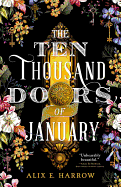
The Ten Thousand Doors of January expands on one of fantasy literature's most common tropes--magical doors into other worlds--to tell a strikingly original coming-of-age story set in the early 1900s. Alix E. Harrow's debut novel follows January Scaller, a ward of the wealthy Mr. Locke and a curiosity among curiosities. Mr. Locke collects exotic objects from around the world and stores them in his mansion. January's father flits in and out of her life, always sent away by Mr. Locke to find more far-flung treasures. January's fascination with Doors begins when she finds one at seven years old and steps into a "world made of saltwater and stone."
The Ten Thousand Doors of January sets itself apart from its influences--C.S. Lewis's wardrobe comes strongly to mind--by focusing on some of the knottier issues of the early 20th-century setting. January is an outsider not only by virtue of her odd relationship with her father, but because of her skin color, an unplaceable shade that Mr. Locke assures her means she is "odd-colored, perhaps, but hardly colored." Harrow is also thoughtful about why the escapist promise of doors to other worlds lingers in our imagination. January finds a book about Doors that contains stories of another young woman "heartsick with the sameness of her days." The plot revolves around unraveling the mysteries of the Doors, of January's parentage and of her relationship to Mr. Locke. Throughout the book, though, Harrow suggests answers to the larger mystery of why people, especially readers, seek to escape into other realities. --Hank Stephenson, former bookseller, Flyleaf Books

